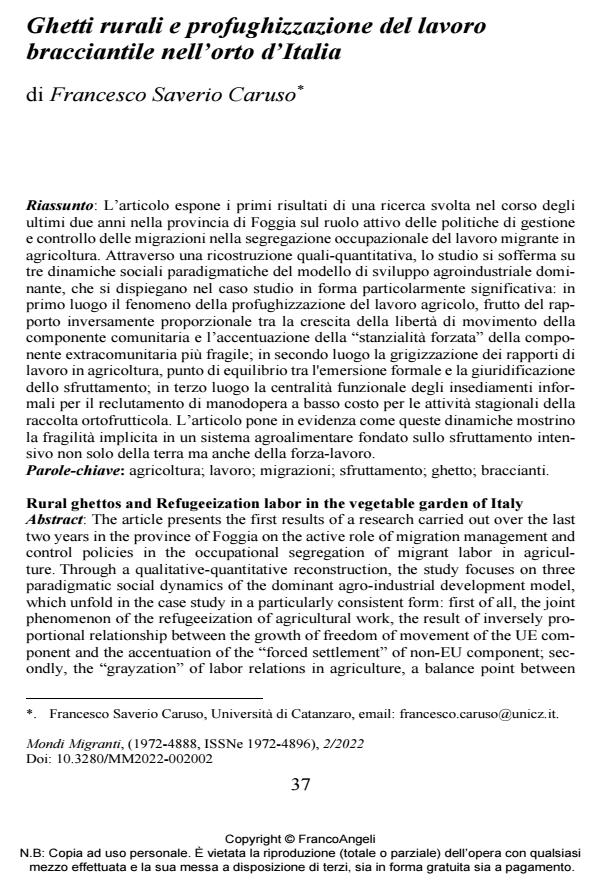Rural ghettos and Refugeeization labor in the vegetable garden of Italy
Journal title MONDI MIGRANTI
Author/s Francesco Saverio Caruso
Publishing Year 2022 Issue 2022/2
Language Italian Pages 16 P. 37-52 File size 185 KB
DOI 10.3280/MM2022-002002
DOI is like a bar code for intellectual property: to have more infomation
click here
Below, you can see the article first page
If you want to buy this article in PDF format, you can do it, following the instructions to buy download credits

FrancoAngeli is member of Publishers International Linking Association, Inc (PILA), a not-for-profit association which run the CrossRef service enabling links to and from online scholarly content.
The article presents the first results of a research carried out over the last two years in the province of Foggia on the active role of migration management and control policies in the occupational segregation of migrant labor in agriculture. Through a qualitative-quantitative reconstruction, the study focuses on three paradigmatic social dynamics of the dominant agro-industrial development model, which un-fold in the case study in a particularly consistent form: first of all, the joint phe-nomenon of the refugeeization of agricultural work, the result of inversely propor-tional relationship between the growth of freedom of movement of the UE com-ponent and the accentuation of the 2forced settlement" of non-EU component; secondly, the "grayzation" of labor relations in agriculture, a balance point be-tween formal legalization and the juridification of exploitation; thirdly, the func-tional centrality of rural ghettos for the recruitment of low-cost labor for seasonal fruit and vegetable harvesting activities. The article highlights how these dynamics show the inherent fragility of an agri-food system based on the intensive exploita-tion not only of the land but also of the workforce.
Keywords: agriculture; labour; migrants; explotation; ghetto; farmwokers.
- Immigrant Work and the Production of Italian Agrifood: The Variants of Subordinate Integration Maurizio Ambrosini, in Journal of Immigrant & Refugee Studies /2024 pp.1
DOI: 10.1080/15562948.2024.2424164 - Infrastrutture della marginalità. Carriere migranti in terra di lavoro Giuseppe Grimaldi, in ECONOMIA E SOCIETÀ REGIONALE 1/2024 pp.141
DOI: 10.3280/ES2024-001011
Francesco Saverio Caruso, Ghetti rurali e profughizzazione del lavoro bracciantile nell’orto d’Italia in "MONDI MIGRANTI" 2/2022, pp 37-52, DOI: 10.3280/MM2022-002002